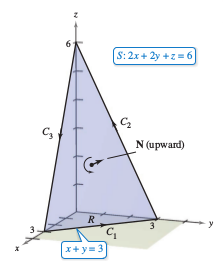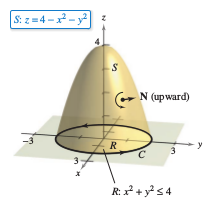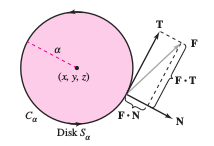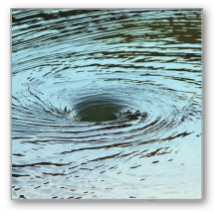Calculus III 15.08 Stokes’s Theorem
| Previous | Calculus III 15.07 Divergence Theorem |
15.08 Stokes’s Theorem[1]
- Understand and use Stokes's Theorem
- Use curl to analyze the motion for a rotating liquid.
Stokes's Theorem
|
|
A second higher-dimension analog to Green’s Theorem is called Stokes’s Theorem, after the English mathematical physicist George Gabriel Stokes[2]. Stokes belonged to the "Cambridge School" along with William Thomson (Lord Kelvin) and James Clerk Maxwell at the University of Cambridge[3]. In addition to making contributions to physics, Stokes worked with infinite series and differential equations, as well as with the integration results discussed here. Stokes’s Theorem describes the relationship between a surface integral over an oriented surface \(S\) and a line integral along a closed three-dimensional curve \(C\) forming the boundary for \(S\), as shown in Figure 15.8.1. The positive direction along \(C\) is counterclockwise relative to the normal vector \( \textbf{N}\). That is, if you imagine grasping the normal vector \( \textbf{N}\) with your right hand, with your thumb pointing in the \( \textbf{N}\)'s direction, your fingers will point in the positive direction \(C\), as shown in Figure 15.8.2. This is a variant on the Right Hand Rule[4]. Theorem 15.8.1 Stokes's TheoremLet \(S\) be an oriented surface with unit normal vector \( \textbf{N}\), bounded by a piecewise smooth simple closed curve \(C\) with a positive orientation. If \( \textbf{F}\) is a vector field whose component functions have continuous first partial derivatives on an open region containing \(S\) and \(C\), then
Note that the line integral may be written in the differential form
or in the vector form
|
Example 15.8.1 Using Stokes's Theorem
|
|
Let \(C\) be the oriented triangle lying in the plane
as shown in Figure 15.8.3. Evaluate
where \( \textbf{F} (x,y,z) = -y^{2}\textbf{i}+z\textbf{j}+x\textbf{k}.\)
Considering
Theorem 15.8.1 can be applied for an upward normal vector to produce
|
Try evaluating the line integral in Example 15.8.1 directly, without using Stokes's Theorem. One way to do this would be to consider \(C\) as the union between \(C_{1}\), \(C_{2}\), and \(C_{3}\), as follows.
| \(C_{1}: \: \textbf{r}_{1}(t) \) | \(= (3-t)\textbf{i}+t\textbf{j}, \: 0 \leqslant t \leqslant 3 \) |
| \(C_{2}: \: \textbf{r}_{2}(t) \) | \(= (6-t)\textbf{j}+(2t-6)\textbf{k}, \: 3 \leqslant t \leqslant 6 \) |
| \(C_{3}: \: \textbf{r}_{3}(t) \) | \(= (t-6)\textbf{i}+(18-2t)\textbf{k}, \: 6 \leqslant t \leqslant 9 \) |
The evaluation works out as
| $$ \int_{C} \textbf{F} \cdot \: d\textbf{r} $$ | $$=\int_{C_{1}} \textbf{F} \cdot \textbf{r}_{1}^{\prime}(t) \: dt + \int_{C_{2}} \textbf{F} \cdot \textbf{r}_{2}^{\prime}(t) \: dt + \int_{C_{3}} \textbf{F} \cdot \textbf{r}_{3}^{\prime}(t) \: dt $$ |
| $$=\int_{0}^{3} t^{2} \: dt + \int_{3}^{6} (-2t+6) \: dt +\int_{6}^{9} (-2t+12) \: dt $$ | |
| $$=9-9-9 = -9. $$ |
Example 15.8.2 Verifying Stokes's Theorem
|
|
Consider the paraboloid \(S\) described by
lying above the \(xy\)-plane and oriented upward, as shown in Figure 15.8.4. Let \(C\) be its boundary curve in the \(xy\)-plane, oriented counterclockwise. Verify Stokes's Theorem for
by evaluating the surface integral and the equivalent line integral.
and
Applying Theorem 15.8.1 produces
As a line integral \(C\) can be parametrized as
For
produces
|
Curl's Physical Interpretation
|
|
Stokes’s Theorem provides insight into a physical curl's interpretation. In a vector field \(\textbf{F}\), let \(S_{\alpha}\) be a small circular disk with radius \(\alpha\), centered at \((x,y,z)\) and with boundary \(C_{\alpha}\), as shown in Figure 15.8.5. At each point on the circle \(C_{\alpha}\), \(\textbf{F}\) has a normal component \(\textbf{F} \cdot \textbf{N}\) and a tangential component \(\textbf{F} \cdot \textbf{T}\). The more closely \(\textbf{F}\) and \( \textbf{N}\) are aligned, the greater the value for \(\textbf{F} \cdot \textbf{T}\). Therefore, a fluid tends to move along the circle rather than across it. This means the line integral around \(C_{\alpha}\) measures the circulation for \(\textbf{F}\) around \(C_{\alpha}\). As an equation,
Consider a small disk \(S_{\alpha}\) centered at some point \((x,y,z)\) on the surface \(S\), as shown in Figure 15.8.6. On such a small disk, curl \(\textbf{F} \) is nearly constant, because it varies little from its value at \((x,y,z)\). Moreover, curl \(\textbf{F} \cdot \textbf{N}\) is also nearly constant on \(S_{\alpha}\) because all unit normals to \(S_{\alpha}\) are about the same. Applying Stokes's Theorem yields
This produces
Assuming conditions are such that the approximation improves for smaller and smaller disks \((\alpha \rightarrow 0)\), if follows that
which is refered to as the rotation for \(\textbf{F}\) about \( \textbf{N} \). As an equation,
In this case, the rotation for \(\textbf{F}\) is maximum when curl \(\textbf{F}\) and \(\textbf{N}\) have the same direction. Normally, this tendency to rotate will vary from point to point on the surface \(S\), and Stokes’s Theorem
says that the collective measure of this rotational tendency taken over the entire surface \(S\) (surface integral) is equal to the tendency for a fluid to circulate around the boundary \(C\) (line integral). If curl \( \textbf{F} =0 \) throughout region \(Q\), then the rotation for \(\textbf{F}\) about each unit normal \(\textbf{N}\) is zero. Therefore, \(\textbf{F}\) is irrotational. This is a characteristic for conservative vector fields. |
Example 15.8.3 Curl Application
|
|
A liquid is swirling around in a cylindrical container with radius 2, so that its motion is described by the velocity field
as shown in Figure 15.8.7 and Figure 16.8.8. Find
where \(S\) is the upper surface for the cylindrical container.
Letting \(\textbf{N} = \textbf{k}\) produces
|
Summary 15.8.1 Integration Formulas
| Fundamental Theorem of Calculus | Fundamental Theorem of Line Integrals |
|---|---|
| $$\int_{a}^{b} F^{\prime}(x) \:dx=F(b)-F(a) \:\:\:\:$$ | $$ \int_{C} \textbf{F} \cdot \: d\textbf{r}= \int_{C} \nabla f \cdot \: d\textbf{r}= f(x(b),y(b)) - f(x(a),y(a))$$ |
| Green’s Theorem | |
| $$ \int_{C} M \: dx + N \: dy = \int_{R} \int \left(\frac{\partial N}{\partial x} -\frac{\partial M}{\partial y} \right) \:dA = \int_{C} \textbf{F} \cdot \textbf{T} \:ds = \int_{C} \textbf{F} \cdot \: d\textbf{r} = \int_{R} \int (\text{curl}\: \textbf{F} \cdot \textbf{k} \: dA $$ | |
| $$\int_{C} \textbf{F} \cdot \textbf{N} \:ds = \int_{R} \int \text{div}\: \textbf{F} \: dA$$ | |
| Divergence Theorem | Stokes's Theorem |
| $$ \int_{S} \int \textbf{F}) \cdot \textbf{N} \: dS = \int \int_{Q} \int \text{div}\: \textbf{F} \: dV$$ | $$ \int_{C} \textbf{F} \cdot \:d \textbf{r} = \int_{S} \int (\text{curl} \: \textbf{F}) \cdot \textbf{N} \: dS$$ |
Internal Links
Parent Article: Calculus III 15 Vector Analysis







